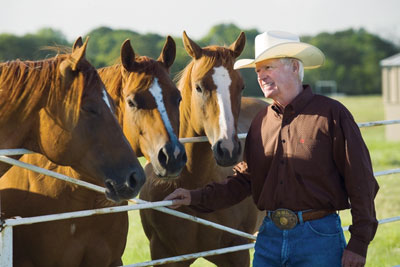
Ron Gabriel
Photos by Randy Mallory
Ron Gabriel’s work commute is short and sweet. It’s a 10-minute pickup ride from his ranch along two-lane country roads, past meadows fringed with forest, to his office in the small East Texas town of Van. He makes the trip a couple of days a week to keep his nationwide oil-field service companies running full tilt.
That’s his day job, the one that pays the bills. But as many hours as he can fit into all the other days, Ron Gabriel raises cattle, horses and hay on four tracts of land that he and his wife, Lana, own in Van Zandt County.
The Gabriels recently moved into their dream home on the largest tract, some 500 bucolic acres blessed with broad rolling pastures mixed with dense woodlands. The rambling lodge-style stone house sits high on a hill, shaded by oaks and overlooking a 25-acre lake, one of 13 lakes and ponds on the property. The couple can sit on their wide flagstone patio and watch Angus cows graze on thick green grass beside the lake to the south. They also can keep an eye on the barns and pens to the east, where they raise a small herd of prized registered quarter horse brood mares.
“I can’t imagine life without agriculture,” Ron says plainly. “That’s a little bit of a surprise, since I’m the only one in my family involved in ranching.”
But that love of the land comes naturally, built from fond boyhood memories of growing up in the 1950s on five acres near Van.
“We need more young people to get into agriculture, and at this stage in my life I just wanted to see if I can help make that happen.” – Ron Gabriel
“We were poor as dirt,” he explains, “but we grew a garden and raised chickens like so many families of the day. We also had a horse named Molly, and when Dad wasn’t plowing with her, I loved to ride her bareback.”
Quarter Horse Savvy
As a young man in the 1960s, Ron bought his own riding horse, and in his spare time he traveled the United States with a friend who judged quarter horse shows. By necessity he built a promising career in the petrochemical industry. By desire he learned the ins and outs of quarter horse bloodlines and the “halter” business, where horses are rated for their conformation and suitability as breeding stock.
In 1990, the Gabriels decided to raise and show their own quarter horses. To begin, they bought 70 acres in Van Zandt County with a loan from Legacy Ag Credit. Gradually, after purchasing quality quarter horses, they added cattle and hay to the operation.
By the mid-1990s, their most famous quarter horse, Clu Heir, had won his first of two world championships. As a stallion, he went on to sire 13 world champions and became the Gabriels’ pride and joy. Meanwhile, in the process of showing Clu Heir and others, Lana Gabriel became a top amateur showing at halter. However, a crushing blow came when Clu Heir took ill and had to be put down. Heartbroken, Lana stopped showing horses. The couple lost interest in the business and sold their horse breeding operation, along with 20 of their 70 original acres.
“With ranching, you’re either in it or you’re not,” says Ron. “I have to be with cows and horses, working with my hands. I enjoy the early mornings, the sweat, the long days. It’s a lifestyle I dearly love.”
Thus, as the pain of losing Clu Heir wore off, the Gabriels added a few brood mares back into their growing ranch operation, and Lana began showing quarter horses again last year.
“She won reserve world champion at Oklahoma City with our gelding,” Ron notes. “After years of not showing, it made her feel good to return at that level.”

The Gabriels plan to breed all of their mares this year and expand the Angus herd they culled last year because of the region’s record drought. Ron also intends to revive an earlier interest and start competing in his age category at team roping events.
Passing It On
Ron Gabriel knows the ups and downs of agriculture from personal experience. He also knows how to build a successful business. He decided last year to put those strengths to work for Legacy Ag Credit, when he accepted an appointment to fill a vacant seat on the Legacy Board of Directors.
“I know business, and I know ranching,” explains Ron, who was elected to a full three-year term on the board this year, “so I thought I might have something to offer. It’s been a great challenge and a great learning experience.”
It’s a good time to serve on the board of a Farm Credit cooperative, he comments. For one thing, the United Nations designated 2012 as the International Year of Cooperatives, which highlights the consumer-owner essence of financial cooperatives. And in just four more years, the nationwide Farm Credit System will celebrate its centennial, which underscores the important role that Farm Credit co-ops continue to play in rural America.
For Ron, it’s also the perfect time to make a contribution. “My service on the Legacy Ag Credit board comes straight out of my love for the land,” he explains. “We need more young people to get into agriculture, and at this stage in my life I just wanted to see if I can help make that happen.”